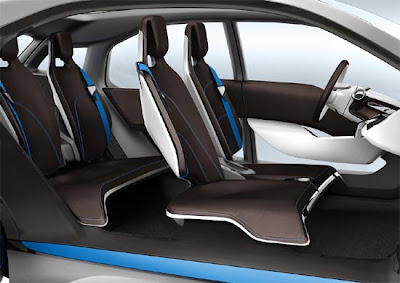CARBARN | BMW Concept i3 | The BMW Concept i3 is an uncompromisingly sustainable vehicle designed for urban areas. Driven purely by electric power and purpose-built to meet the demands of sustainable and emission-free mobility, it embodies an intelligent form of urban transportation and commuting. It is the world's first premium electric vehicles. Andrew Feist, Head of BMW i3 vehicle project. Central to its design is the innovative LifeDrive architecture, the key to the BMW i3 Concept's appeal as a light, safe and spacious car. Innovative use of lightweight materials and intelligent design not only enable the i3 Concept to travel long distances on a single charge and Provide superb safety in the event of a collision, They also help give the car its excellent driving dynamics. The secure arrangement of the battery module in the Drive Gives the vehicle a very low center of gravity and optimum weight distribution. The Life module conjures up a feeling of space inside the car even more generous than the latest conversion vehicles can offer. Select materials Lend the open and airy cabin is a lounge-like character.
With the drive components located in the Drive module, there is no center tunnel running through the passenger compartment. With ECO PRO mode activated, all functions operate the vehicle with maximum efficiency. Added to which, sophisticated aerodynamics and slim, low rolling resistance wheels minimise resistance to the car's forward progress and maximise its range. Innovative connectivity functions create a seamless connection i3 Between the BMW Concept and its customers' lives outside the car. Remote functions accessible via a smartphone enable owners to find Their vehicles, flags up nearby charging stations, battery charging and allow preconditioning at the touch of a button and supply information on the current status of the vehicle.
This involves Integrating components into electric vehicles originally designed to be powered by a combustion engine, as in the case of the MINI E and BMW ActiveE test cars. The BMW Group engineers took a different approach, focusing squarely on the eventual usage of the BMW i vehicles in developing the concept LifeDrive. This new vehicle architecture meets the full range of technical requirements of an electric drive system (including a large battery), while keeping weight low, maximising range, creating generous levels of space, enabling supreme driving characteristics, impressive and ensuring safety for the battery and passengers alike.
In contrast to vehicles with a self-supporting body, the LifeDrive concept essentially comprises two separate, independent functional units. The Drive module integrates the vehicle's suspension, battery, drive system, and structural and crash into a construction functions chiefly made from aluminum. Its partner, the Life module, consists primarily of a high-strength and extremely lightweight passenger cell made from carbon fiber-reinforced plastic (CFRP). By avoiding the need for modifications to accommodate the electric drive components, the LifeDrive architecture ensures the car is no heavier than a conversion vehicle of similar size. Intelligent lightweight design and the innovative use of materials allows the LifeDrive architecture to cancel out all the extra weight added by giving the car an electric drive train rather than a comparable combustion engine.
Another special feature of the BMW and BMW i8 i3 Concept Concept Their wheels are, the which are noticeably larger and narrower than Those of Their class rivals. Equally impressive as the vehicle architecture's benefits in terms of weight and handling is its performance in crash tests. Here again, the combination of the aluminum in the Drive module and the module's Life CFRP passenger cell demonstrates just how well lightweight design and safety can go together. Pole Impacts, side-on collisions and rollover tests highlight the impressive safety-enhancing properties of this material extraordinarily robust. While metal Constructions require the Addition of large energy absorption zones, special deformation elements in the CFRP structure allow large amounts of energy to be absorbed in an amazingly small area. Together, the high-strength CFRP passenger cell and intelligent distribution of forces through the LifeDrive module lay the foundations for optimum protection for the car's occupants and battery alike












